If you have been around gaming laptops or the gaming community you will definitely have heard about thermal paste or grease.
Thermal paste is quite a popular product because of its purpose. Imagine your laptop overheating anytime you play games. It is a quick solution to solve overheating on your PC or laptop.
Planning to overclock and afraid about the high temperatures? Thermal paste will solve the problem. The thermal paste acts as a bridge between your CPU/GPU and the heatsink for the heat to cross.
You get the point now. It is an indispensable product when it comes to solving overheating or high-temperature problems.
In this article, you will know the best ways how to apply thermal paste.
What Is Thermal Paste And Its Purpose?
Thermal paste or thermal grease is a compound used to eliminate air spaces between CPU/GPU and a cooling system/heatsink.
Thermal pastes have high heat conductivity and are usually made from compounds like powdered silver, aluminium and silicon.
Overheating can cause a lot of problems to your laptop or PC. It can cause thermal throttling, random shutdowns and even cause some damage to the internal components.
Inside your laptop, the heatsink or cooling system is in contact with your CPU/GPU. This allows heat to be transferred from the CPU/GPU to the heatsink which then the fan gets rid of it through the vents.
The two (heatsink and CPU/GPU) are supposed to be touching before heat transfer can take place. This is not the case most of the time.
Because the two surfaces (CPU/GPU and heatsink) are not perfectly flat. Air is trapped between them. And the air is a bad conductor of heat.
You will not be able to see unless you use a microscopic. So even though both surfaces are in contact there will be gaps containing air.
This reduces the overall effectiveness of the heatsink/cooling system because air is a bad conductor and heat will not be able to transfer efficiently from the CPU/GPU to the heatsink leading to high temperatures.
This is where the thermal paste or grease comes in. The thermal paste fills all the gaps making sure that heat will be able to get to the heatsink from the CPU/GPU.
Thermal pastes are particularly useful when you plan to overclock your laptop’s CPU/GPU because of large amounts of heat produced.
Types Of Thermal Paste/Grease
There are several types out there but they all fall under these four: metal-based, ceramic-based, carbon-based and silicon-based.
Metal-based Thermal Paste
There is the normal metal-based paste which has particles of metals (silver and aluminium) in them and the more expensive liquid metal-based paste which has rare metals in them.
The normal metal-based paste has the best conductivity out of all the thermal pastes.
The liquid metal-based paste has higher conductivity than the normal metal-based paste and is more expensive because of the rare metals they contain.
Both are highly capacitive and will cause problems if some get onto your motherboard.
Ceramic-based Thermal Paste
Ceramic-based thermal pastes are the most popular and commonly used out of all the thermal pastes. They are not capacitive and are also very cheap to obtain. The decrease in temperature is not as much as metal-based thermal pastes.
Carbon-based Thermal Paste
As the name implies they contain fibres of carbon. Carbon is a good conductivity of electricity because of the free electrons it has made it behave like a metal. This also makes it a good conductor of heat.
Silicon-based Thermal Paste
Silicon-based thermal pastes are pre-applied to the stock heatsinks. These usually come with cooling kits.
How Much Thermal Paste Do I Need For Laptop?
Too little thermal paste is always better than too much or a lot. Too much and some will just get to your motherboard or be too thick to transfer heat from the CPU/GPU to the heatsink efficiently.
Best way to go is to apply a small amount and monitor your laptop. If there are no problems you are good to go.
But, if problems still persist that’s the signal that you need to apply a little more. Repeat this until you achieve the desired results.
How To Apply Thermal Paste Laptop?
There are several ways you can apply thermal paste. You can even check out Arctic Silver’s website.
It tells you the application method for best results depending on your PC’s or Laptop’s CPU whether it is from Intel or AMD.
Dot Method
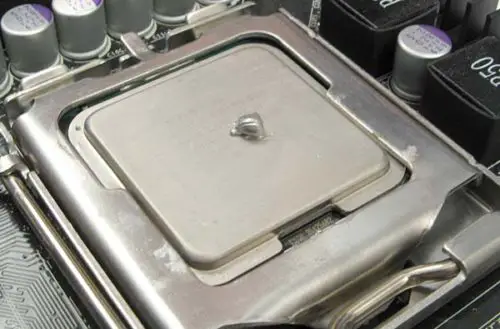
The most recommended way of application is the “dot” method where you place a pea-sized or rice-sized amount of thermal paste in the centre of the CPU.
This method is recommended because of the even spread that happens when you put everything back together resulting in better performance and solving your overheating problems.
Line Method
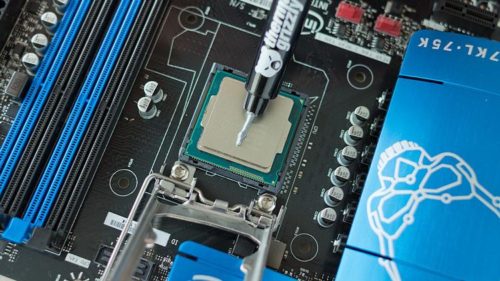
The line method is done by placing two parallel lines that are about a third of the processor’s width. You can also use a single line that is equal to the length of the processor and runs through the centre of it.
Cross or X Method
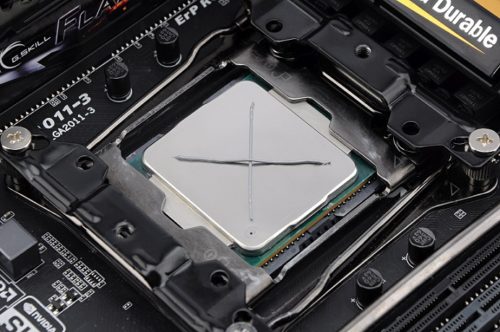
The “X” is done by crossing two lines in an X shape. Lines should start from the corners and run through the centre to the other corner.
Spread Method
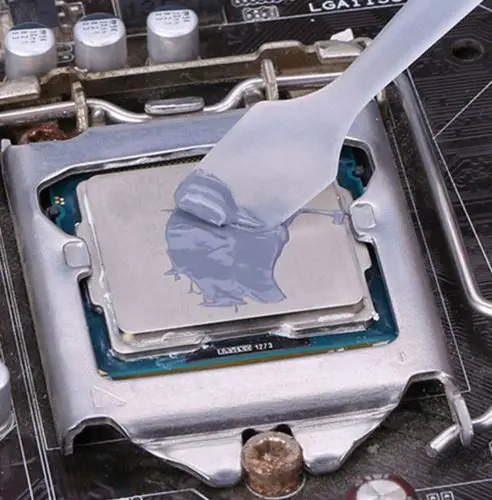
The spread method is done by applying some thermal paste on the CPU which is then spread out to cover the entire surface of the CPU using a card or your finger covered in plastic.
4 steps To Follow On How To Apply Thermal Paste Laptop
- If you want to apply thermal paste, first you need to open up your laptop and locate where the CPU or GPU is.
- Clean the dust and dirt from your laptop.
- After that use, a paper towel dipped in isopropyl alcohol (any alcohol is good so far as it is 80 per cent plus) to clean the surface of the CPU/GPU. Make sure it is neat. No dust. No dirt.
- Apply a small amount of thermal paste on top of the CPU. Not the sides or on the motherboard but on top. The method you want to apply is up to you. Although the most recommended is the “dot” method. Apart from the spread method, there is no need to spread the thermal paste to cover the CPU. It will spread itself once you fix everything back.
- When you are done close everything up and start up your laptop to see if temperatures are better. If it doesn’t increase the amount of thermal paste applied until you achieve desired results. There is also the option of undervolting for best results.
- The process of applying thermal paste is almost the same throughout up until the method of application.
How To Get Rid Of Thermal Paste?
Getting rid of thermal paste is very easy. You just need a paper towel or cloth and some alcohol.
No, we are not talking about alcohol from the bar. We are talking about a solution that has more than 80 per cent of alcohol in it. The higher the concentration the better.
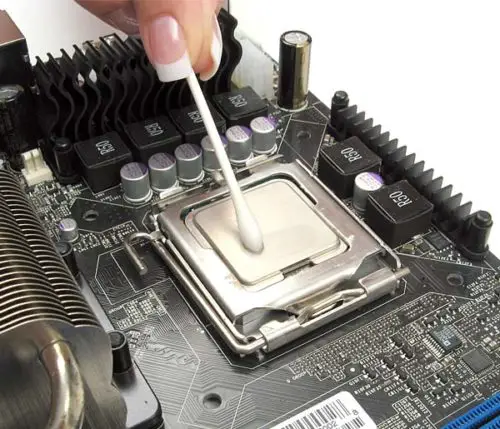
Thermal paste is known to get very hard when dry due to the constant high temperatures they are subjected to over a long period of time.
Get your paper towel ready.
Avoid cloth that leaves pieces around after being used. Use a dry paper towel to wipe the surface of the CPU to get rid of a lot of thermal paste as much as possible.
Get your alcohol (ethanol or isopropyl) ready. Dip your towel in the alcohol and wipe the thermal paste off.
Keep doing it until you can see your reflection on the CPU. You can then choose to re-apply a new thermal paste if you want.
Is Thermal Paste Safe?
Yes, thermal paste is safe to use and touch. It only becomes dangerous if you ingest it. Apart from that, you won’t experience any health problems using thermal paste. Just wash your hands after use.
How Long Does Thermal Paste Last?
Thermal paste will definitely degrade as time goes on and also because of the high temperatures is subjected to.
As a rule of thumb if you notice the problems are recurring either you have to apply more thermal paste or its time to get rid of it.
Some companies also add when thermal paste should be reapplied. Reapplication every two years or following the above method is a good way to know when you need to replace your thermal paste.
Thermal Paste Alternatives
There are several thermal paste alternatives. The common is toothpaste. There is also hair wax (strange, right?), banana, paper, etc.
If you decide to go down this route make sure to check forums and do your research well before applying them.
Final Thoughts
Thermal paste is super helpful in controlling high temperatures. The ease of application also makes it the go-to method. Another way of reducing high temperatures is by undervolting and underclocking.
Combining the two will always provide the best results in preventing overheating.
That’s it on how to apply thermal paste laptop.
